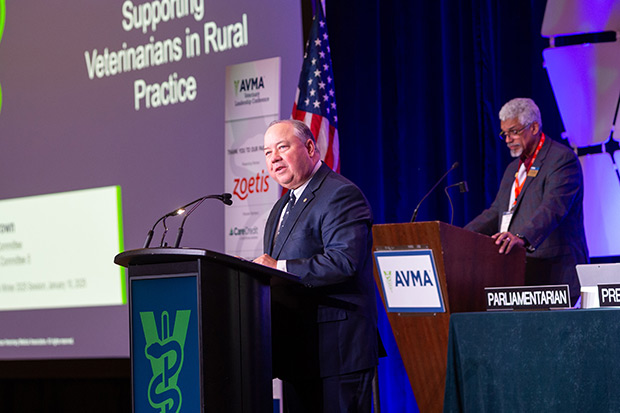AVMA leaders discuss how to strengthen rural veterinary medicine

AVMA leaders discuss how to strengthen rural veterinary medicine
Story and photo by R. Scott Nolen
Delegates call for AVMA Board action to overcome recruitment, retention challenges.
The AVMA House of Delegates (HOD) asked the AVMA Board of Directors (BOD) to consider prioritizing resources in support of veterinarians in rural practices, including using data-driven resources to identify factors influencing recruitment and retention, and partnering with other professional organizations facing similar challenges.
“This isn’t just about supporting individual veterinarians. It’s about ensuring that rural communities continue to have access to essential veterinary care. By addressing these challenges head on, we can create a brighter future for veterinarians and the communities they serve,” said Dr. Stuart Brown, delegate for the American Association of Equine Practitioners.
Delegates passed this recommendation during the House’s regular annual winter session on January 11 in Chicago, which was held concurrently with the 2025 AVMA Veterinary Leadership Conference. The action was born out of discussions from the House’s Veterinary Information Forum (VIF) held the previous day on how the AVMA can best support veterinarians working in rural America.
Challenges and opportunities
Dr. Brown opened the forum with a presentation in which he described rural veterinarians as “the backbone of animal health” in many communities.
“Their work impacts food safety, public health, and the wellbeing of animals and people alike,” he said. “Yet, the demands they face are substantial, and we need to work collectively to provide the resources and support they need to thrive.”
Delegates discussed these challenges, including limited access to advanced diagnostic tools; smaller client bases compared with urban practices; long hours; and physically demanding work, particularly for large animal veterinarians. These issues are exacerbated by lower starting salaries, professional isolation, and potentially more limited employment and educational opportunities for family members in rural areas.

Cultural differences and safety concerns associated with working in remote areas were also raised.
“Women in rural veterinary practice often face unique obstacles,” said Dr. Leah Trapp, president of the National Association of Federal Veterinarians. “From personal safety concerns to receiving unwanted communications in isolated settings, these are real issues that we must address. It’s not just about the money—this is about creating safe, welcoming environments for all veterinarians.”
Despite the hurdles, participants celebrated the benefits of rural practice, such as a lower cost of living, diverse and stimulating caseloads, and opportunities to make a lasting impact on communities.
Dr. Brown shared a personal story about Dr. William Holbrook, a rural veterinarian in Kentucky. “Dr. Holbrook didn’t just care for animals; he mentored countless veterinarians and became a leader in his community,” he recalled.
Delegates mentioned several strategies to support rural veterinarians. Federal and state educational loan repayment programs emerged as a key solution, along with flexible work arrangements and targeted mentorship initiatives. VIF participants also noted the potential of emerging technologies, such as telemedicine, remote monitoring, and artificial intelligence (AI), to help manage workloads and improve efficiency in rural settings.
Recruitment efforts were another major focus. Attendees agreed on the importance of engaging students early by offering shadowing opportunities, mentorship programs, and scholarships.
“We need to plant the seeds of interest in veterinary careers as early as high school,” said Dr. Kaitlyn Boatright, Pennsylvania alternate delegate. “Programs that expose students to the unique rewards of rural practice can make a huge difference.”
The forum also addressed the pressing issue of declining numbers in rural veterinary practice. Dr. Thomas Vermeersch, the U.S. Department of Agriculture’s Food Safety and Inspection Service representative on the House Advisory Panel, pointed to data showing a sharp drop in mixed animal and food animal veterinarians over the past decade, despite an overall increase in clinical practitioners.
“We’ve seen a 15% decrease in rural veterinarians while the field, as a whole, has grown. What we’ve been doing clearly isn’t enough. We need to study successful practices and figure out what’s working—and what’s not,” Dr. Vermeersch said.
A recurring theme throughout the forum was the need for partnerships with other professional organizations, such as the American Medical Association and American Dental Association, to identify resources and programs that have addressed similar challenges with positive impacts.
Action items
Following the VIF, a reference committee to the HOD, chaired by Dr. Brown, developed a list of potential action items to support rural veterinarians that the AVMA Board might consider. They include:
- Data-driven resources that identify factors that impact retention of veterinarians in rural practice
- Potential model programs from other health professions
- A survey of existing programs that have provided substantial support for veterinarians in rural practice
- With respect to the area of emerging technologies, forms of AI that could be identified by the AVMA that meet some of the unique needs of rural practitioners (e.g., medical record keeping software)
- Member benefits that exist within AVMA-affiliated groups that seek to address the unique needs of rural practitioners (e.g., AVMA Trust)
- Strategies developed for enhanced utilization of members of veterinary workforce teams that can support members in rural practice (e.g., licensed veterinary technicians and veterinary technologists, approaches to employment practices that lead to shared responsibilities by veterinarians)
The motion passed with a strong majority, signaling widespread support for advancing the sustainability of rural veterinary careers.
“Together, we can ensure that rural veterinary practice remains a rewarding and viable career path,” Dr. Brown said. “It’s not just a job—it’s a calling, and it deserves our full commitment.”
A version of this story appears in the March 2025 print issue of JAVMA
Dr. K. Fred Gingrich II, executive director of the American Association of Bovine Practitioners, shared his thoughts on how to improve efforts and interventions in increasing the number of veterinarians in rural veterinary medicine and food animal practice. Among his suggestions, he advocated for studies evaluating successful practices in rural areas and how they are able to retain associates. (Video by Matt Zingale)

